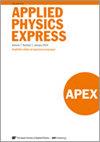基于石英晶体微天平法阻抗数据的分层聚合物溶解模型
IF 2.2
4区 物理与天体物理
Q3 PHYSICS, APPLIED
引用次数: 0
摘要
在光刻技术中,显影过程对于实现高保真效果至关重要。石英晶体微天平 (QCM) 方法是通过测量抗蚀聚合物的频率和阻抗来分析其溶解动力学的主要工具。然而,阻抗图的利用率却很低。我们提出了分层聚合物溶解模型 (SPDM),以模拟显影剂中的聚合物溶解并分析 QCM 图表。利用 SPDM,我们准确地再现了频率图和阻抗图。我们成功地从 QCM 图表中提取了描述溶解动力学的特征值,从而能够研究显影剂对溶解动力学的影响。本文章由计算机程序翻译,如有差异,请以英文原文为准。
Stratified polymer dissolution model based on impedance data from quartz crystal microbalance method
In lithography, the development process is essential for achieving high fidelity. The quartz crystal microbalance (QCM) method is a primary tool for analyzing the dissolution kinetics of resist polymers by measuring their frequency and impedance. However, impedance charts are underutilized. We propose a stratified polymer dissolution model (SPDM) to simulate polymer dissolution in developers and analyze QCM charts. Using SPDM, we accurately reproduced both the frequency and impedance charts. The feature values describing the dissolution kinetics were successfully extracted from the QCM charts, enabling the investigation of the effects of developers on dissolution kinetics.
求助全文
通过发布文献求助,成功后即可免费获取论文全文。
去求助
来源期刊

Applied Physics Express
物理-物理:应用
CiteScore
4.80
自引率
8.70%
发文量
310
审稿时长
1.2 months
期刊介绍:
Applied Physics Express (APEX) is a letters journal devoted solely to rapid dissemination of up-to-date and concise reports on new findings in applied physics. The motto of APEX is high scientific quality and prompt publication. APEX is a sister journal of the Japanese Journal of Applied Physics (JJAP) and is published by IOP Publishing Ltd on behalf of the Japan Society of Applied Physics (JSAP).
 求助内容:
求助内容: 应助结果提醒方式:
应助结果提醒方式:


